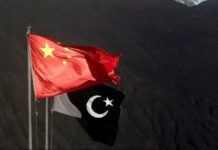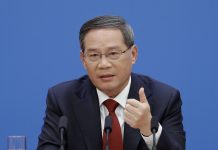The COVID-19 pandemic is a major public health emergency that has spread the fastest, caused the most extensive infections and been the hardest to contain since the founding of the People’s Republic of China in 1949. With joint efforts of the whole nation, a positive trend in preventing and controlling the epidemic has prevailed in China, while the resumption of production and normal life is quickening. But the disease poses a “formidable challenge” to global public health security as it has been spreading rapidly in the world. According to data from the World Health Organization (WHO), COVID-19 had affected more than 200 countries and regions with over 1.13 million confirmed cases by April 5. Virus knows no national borders, and the epidemic distinguishes no races. Only with solidarity and cooperation can the international community prevail over the pandemic and safeguard the common home of humanity. Upholding the vision of building a community with a shared future for humanity, China has been timely releasing information on COVID-19 since the onset in an open, transparent and responsible manner, unreservedly sharing with WHO and the international community its experience in epidemic response and medical treatment, and strengthening cooperation on scientific research. It has also provided assistance to all parties to the best of its ability. Disclosure of information Since the outbreak, the Chinese Government has released information about the epidemic in a timely, open, transparent and responsible manner, actively responded to concerns of all sides, and enhanced cooperation with the international community. On December 30, 2019, the Wuhan Municipal Health Commission sent out an urgent notification to medical institutions under its jurisdiction about an outbreak of pneumonia of unknown cause in the capital city of Hubei Province in central China. On receiving the report of the outbreak, the National Health Commission (NHC) dispatched a working group and an expert team to Wuhan to guide epidemic response and conduct on-site investigations. One day later, the Wuhan Municipal Health Commission released its first briefing on the outbreak on its website, confirming 27 cases and warning the public not to go to enclosed public places or gather in large crowds. The residents were also advised to wear face masks when going out. From then on, the commission had released briefings on the outbreak in accordance with the law. The NHC started to provide updates via its official website and its new media platform on a daily basis from January 21. WHO, relevant countries and regions, as well as China’s Hong Kong, Macao and Taiwan have been regularly informed about the outbreak since January 3. Starting from that day, China began to inform the U.S. of the outbreak and response measures on a regular basis. On January 8, when an expert evaluation team from the NHC initially identified a new coronavirus as the cause of the epidemic, heads of Chinese and U.S. centers for disease control and prevention talked over the phone to discuss technical exchanges and cooperation. Starting February 3, the English website of the NHC started to release epidemic information simultaneously. From January 3 to February 3, China gave the U.S. briefings on the epidemic information and control measures 30 times, including sharing with the U.S. Centers for Disease Control and Prevention’s project manager in China information about diagnosis and treatment guidelines, prevention and control guidelines, and the link of the novel coronavirus database that China shares with the world in real time. Chinese President Xi Jinping spoke over the phone about the epidemic with the leaders of dozens of countries and regions as well as international organizations, including U.S. President Donald Trump and UN Secretary General AntónioGuterres. During a phone call with Trump on February 7, Xi said China has kept WHO as well as relevant countries and regions, including the U.S., posted on the epidemic with an open, transparent and responsible attitude, and invited WHO and other experts to conduct field visits in Wuhan. The NHC gave briefings on China’s anti-epidemic efforts and measures at the first meeting of the Asia-Pacific Economic Cooperation health working group on February 8. On February 12, specialists from the NHC joined a China-EU teleconference on COVID-19-related technical exchanges, describing the latest developments in the epidemic, prevention and control measures, and the situation of international cooperation. Starting February 16, a China-WHO joint expert team, which consisted of 25 experts from China, Germany, Japan, the Republic of Korea, Nigeria, Russia, Singapore, the U.S. and WHO, conducted a nine-day field visit in China, inspecting cities including Beijing, Chengdu, Guangzhou and Wuhan. Under China’s joint prevention and control mechanism of the State Council, a press conference has been held every day since January 27, updating data on a daily basis, including new confirmed cases, severe cases, deaths and suspected cases, and giving briefings on the country’s measures to fight the epidemic and minimize its impact on social and economic development. The NHC shared on February 25 updated technical guidelines on COVID-19 response with a number of countries and regional organizations. Research cooperation In the global fight against the coronavirus, China has attached great importance to the role of scientific research, with scientists releasing their latest research results. China has timely shared with the world the whole genome sequence, primers and probes of the coronavirus, and diagnosis and treatment guidelines and other technical documents with more than 100 countries and over 10 international and regional organizations. By carrying out timely technical exchanges with the international community, such as WHO, the U.S., and countries in Europe, Asia and Latin America, Chinese scientists and health experts shared their knowledge about the virus with global peers to help them develop test kits and adopt responsive measures. After the Chinese Center for Disease Control and Prevention (China CDC) succeeded in isolating the first novel coronavirus strain on January 7, an expert team from the NHC made public the pathogen two days later, saying a new type of coronavirus was identified as the cause of the viral pneumonia in Wuhan. On January 12, China CDC, the Chinese Academy of Medical Sciences and the Wuhan Institute of Virology under the Chinese Academy of Sciences submitted to WHO the genome sequence of the novel coronavirus, which was published by the Global Initiative on Sharing All Influenza Data and shared globally. As Chinese researchers and doctors deepened their understanding of the coronavirus, the NHC updated different versions of guidelines on diagnosis and treatment of COVID-19 and made them available globally. Assistance to other countries China has also helped other countries fight the pandemic to the best of its capacity, providing medical supplies or sending medical experts. It announced a donation of $20 million to WHO on March 7 to support international cooperation in the fight against COVID-19. A spokesperson for the Ministry of Foreign Affairs said at a press conference in Beijing on March 8 that while overcoming its own difficulties, China is willing to provide masks and other medical protection materials to relevant countries to support them in fighting the pandemic. The first batch of Chinese medical experts carrying medical supplies arrived in Italy on March 12. More medical experts and supplies from China arrived in the European country later to help with its epidemic prevention and control efforts. Medical experts and supplies were also sent to countries such as Iran, Iraq, Serbia, Cambodia, Pakistan, Laos and Venezuela. By March 31, the Chinese Government had provided material assistance including medical masks, N95 filters, protective suits, nucleic acid testing reagents and ventilators to 120 countries and four international organizations. Local governments in China donated medical supplies to more than 50 countries. And Chinese enterprises donated medical supplies to more than 100 countries and international organizations. Global recognition WHO said on January 9 on its website that preliminary identification of the novel coronavirus in a short period of time was a notable achievement. On January 13, it issued another statement on the discovery of the novel coronavirus cases in Thailand, pointing out that China’s sharing of the genome sequence enabled more countries to quickly diagnose patients. WHO Director General TedrosAdhanomGhebreyesus on January 24 thanked on social media the Chinese Government for its cooperation and transparency, saying the Chinese Government has been successful in isolating and sequencing the virus quickly and has shared that genome sequence with WHO and the international community. German Chancellor Angela Merkel said Germany appreciates China’s efforts to respond in a timely manner, stay open and transparent, and actively carry out international cooperation. On February 24, the China-WHO joint expert team held a press conference in Beijing. The team members said China’s unprecedented public health responses to the COVID-19 outbreak have yielded notable results in slowing the spread of the epidemic and blocking human-to-human transmission of the virus, preventing or at least delaying hundreds of thousands of cases.-The Daily Mail-Beijing Review News exchange items





